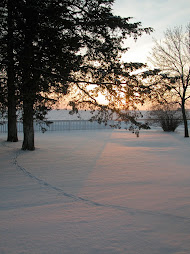Here was my opening:
Their portraits hang in oval frames.
His, hanging on the left, shows him striking a pose with his right shoulder pointed into the camera. The angle forces him to crane his head around with a tilt. His grin comes easy — as if it’s been a good enough day that humoring the photographer’s instructions to turn, tilt then hold that smile isn’t an imposition. His suit is neat yet slightly tattered at the seam. The jacket isn’t as old as he; he just wore better. He has two patches of neatly-groomed hair above each ear. The arc of his nose gives away the secret of his homeland — it’s a jewel of the Mediterranean.She’s photographed later in life. Her hair is white and neatly plastered to her scalp in tight waves that frame a square face. Her jaw tells me she’s one to be reckoned with; her eyes counter with, “I love you regardless.” Her most outstanding feature is her eyebrows; they’re thick and black, an underscore to the pale complexion revealed in grayscale. She wears a frock in black and white paisley. It’s a grandmother’s dress — well suited for woman who was mother to nine, grandmother to 19 and great-grandmother to 45, including me.
Between the portraits which hang behind tempered glass, the first names of their children are listed … Mike … Ann … Louis … Mary … Art … John … Marcella. The inscription that accompanies the names reads: “As they carried their Maronite tradition and Lebanese heritage in their hearts, may generations after them cherish it. Cedars Hall is dedicated to the memory of Betros and Zmeroud Nasseff by their children.” Adjacent to the display case, which is built into the foyer of a modern yet ancient Minneapolis church, is a mural depicting an unnamed mountain village in Lebanon.
I look into the framed faces — Betros, then Zmeroud, then Betros again. There’s something hidden in the eyes I can’t quite decipher. I examine the list of names again. Mike … Ann …. I stop at Ann.
My grandmother is the only one on the list I knew in any meaningful sense, and truth be told, I didn’t know her at all. She’s a faint memory, a series of flashing images and sound bites from childhood: haggling over prices at a garage sale, strawberry picking on a bright June morning, the place she shared with Helene on Randolph Ave., scaling a riverbank to pick grape leaves, hugs (always hugs), and a couple of blazingly hot visits to California. Then darkness falls over the screen and the memory show ends.
I stare at the letters. A-N-N. The lines of the letters rise, then fall, and rise again only to repeat the fall. Her life, what I know of it, rose and fell in sharp angles too. The last line of the last N rises then stops, name over … life over. It’s a hopeful sign if, like me, you believe there’s a heaven. It’s a short name; too short to do her justice. A name should be a melody, a spiritual that revels in life’s lyric. A good name should be heavily laden with syllables and vowels; it should ring of history. Ann, dead for almost 20 years, was more than three letters’ worth of woman.
Suddenly, the door to Cedars Hall swings open and a black-haired moppet dressed for Christmas in red velvet and taffeta darts past me on her way to the bathroom. The din of conversation and laughter swells as the door hangs open which yanks my attention away from A-N-N. I need to get back inside, but before I return to the room I pause a moment longer with Zmeroud and Betros.
My memory show of Zmeroud is shorter than Ann’s. It lasts less than 5 seconds and doesn’t have sound. I see a tiny apartment and crooked fingers filling a dish with black olives. That’s all I have.
Memories of Betros don’t exist within me. He died in 1947; I was born in 1960. He is a complete stranger I want to place in my past but can’t. He’s like the man sitting across a restaurant you recognize but aren’t quite sure from when or where. You rack your brain during your whole meal and it never comes to you and even though you could save yourself all the trouble by just walking up to him and asking: “Don’t I know you from somewhere?” You don’t. You don’t have the guts, after all; plus you don’t want to look like a fool. So, you end up leaving the restaurant and it bothers you all the way home until his face fades into the night along with the sounds that filled the restaurant and the taste of the meat you ate that night.
Betros is that man in the restaurant. He looks just like a man I’ve known and loved my entire life except he’s a stranger locked in a gilded oval frame. Maybe I know him; maybe I’m wrong. Maybe if I rack my brain long enough it will come to me. Probably, I could just ask someone inside the hall and move on. But then, I don’t have the guts.
With a quick brush of fingers through hair, I turn and walk back to the Christmas party going full tilt inside Cedars Hall — a room filled with family, a room full of strangers.






2 comments:
I think you should write the book!
Thanks for your encouragement!
Post a Comment